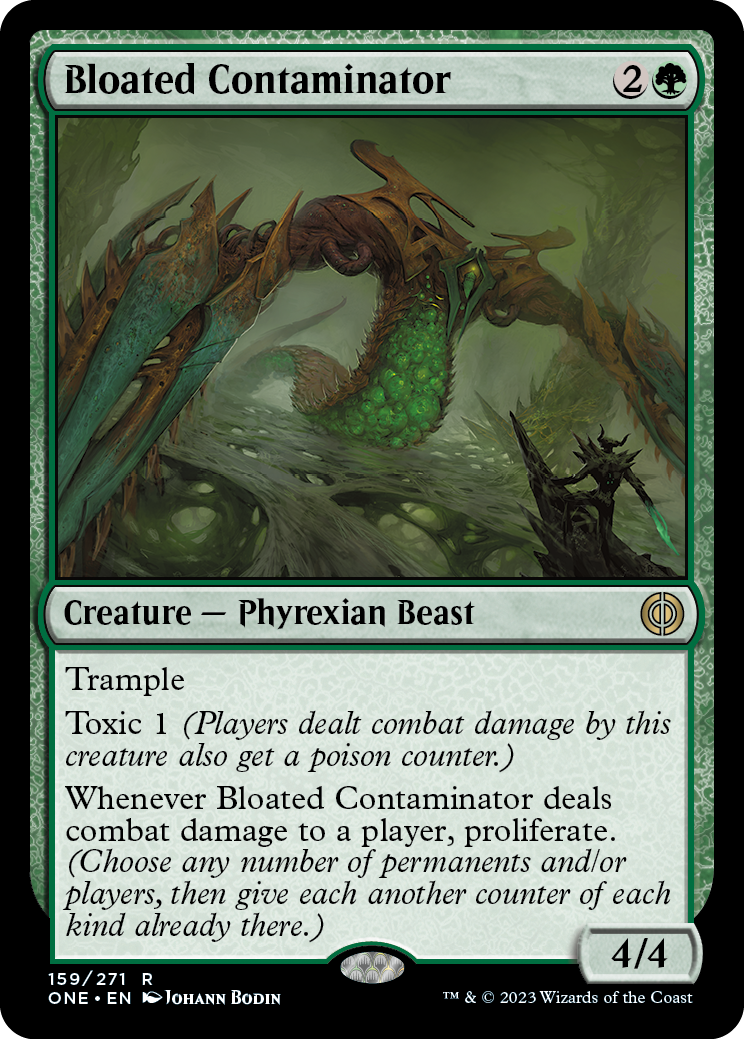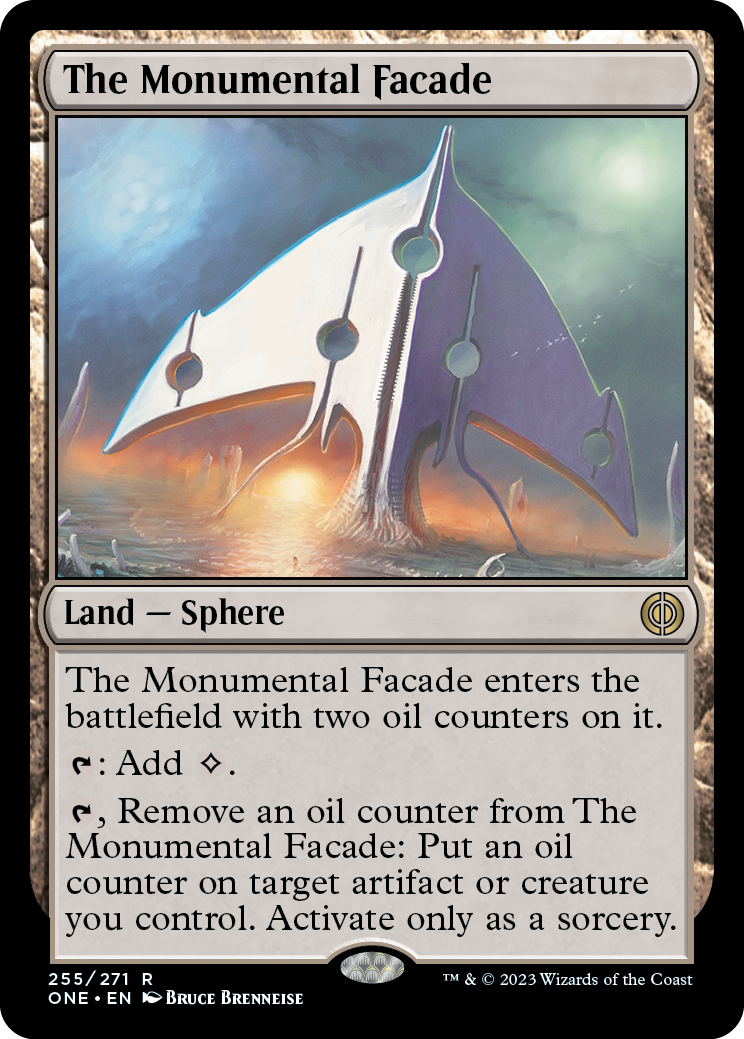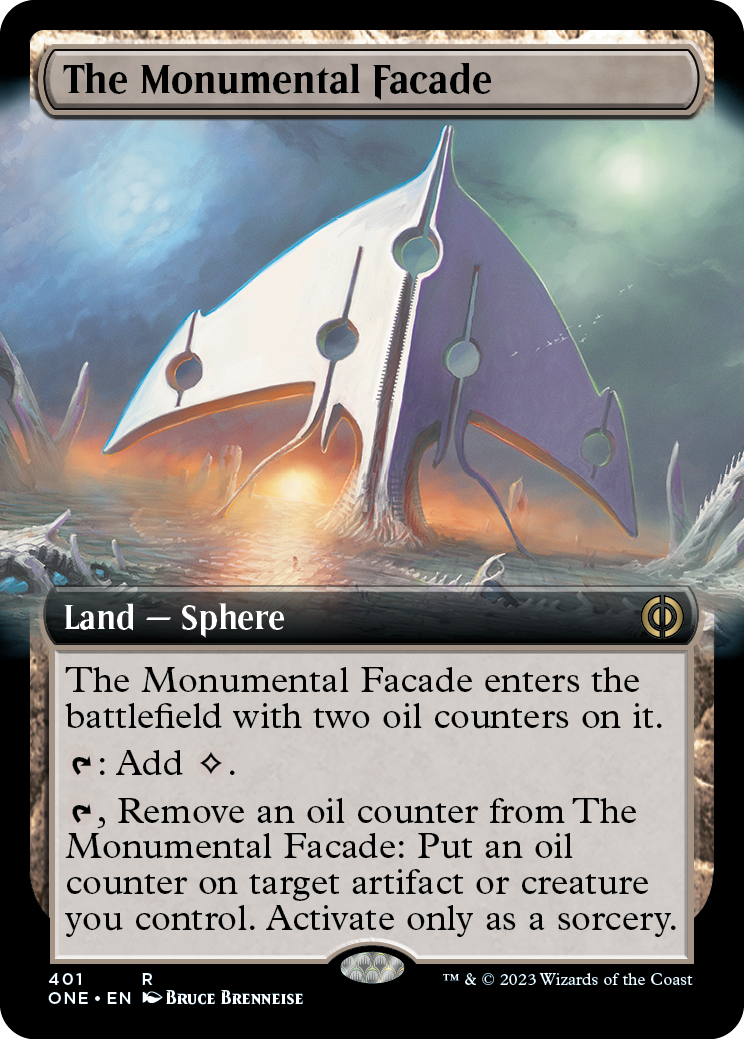Phyrexia: All Will Be One Direction, Part 1
Welcome to the first week of Phyrexia: All Will Be One card previews. I'm going to introduce the Exploratory Design and Vision Design teams, start telling the story of the set's design, and show off two cool new preview cards. It's an interesting story, so let's get to it.
The Compleat Story
Before I begin telling the story of Phyrexia: All Will Be One's design, I would first like to introduce the Exploratory Design and Vision Design teams who worked on the set. Next week, I'll introduce you to the Set Design team. As always, I have the lead designer of the team(s) do the introductions, and for this set, that was me.
-
Click here to meet the teams
-
Mark Rosewater (exploratory design and vision design – lead)
I'm a huge fan of the Phyrexians. My favorite set before I came to work for Wizards was Antiquities (where the Phyrexians premiered). When Michael and I created The Weatherlight Saga, we made the Phyrexians the main villains. I chose to lead the design for Scars of Mirrodin, which reintroduced the Phyrexians. So, when it came time for us to make the Phyrexian set, the one expansion of the story actually set on New Phyrexia, I knew I had to lead it. I'm glad I did as I'm very happy with how it turned out.
Doug Beyer (exploratory design and vision design – strong second)
Doug is on most Vision Design teams as the representative of the Creative team. While we figure out what the set is mechanically about, Doug and his team are figuring out how to build the world and story. On this set, though, Doug had an additional role, a pretty big one. He was my strong second for both exploratory design and vision design. Doug did this as preparation for leading the vision design for "Rugby" (coming out this year). This was Doug's first time as a strong second, and he did an excellent job.
Ari Nieh (vision design)
It's become kind of cliché to call Ari a great designer (as she was the winner of Great Designer Search 3), but it's still true. Ari was super helpful in vision design with asking some big-picture questions that helped us get the design to where it was handed off. I'm grateful that Ari was on the team and enjoyed all of her insight.
Bryan Hawley (vision design)
Bryan was on the team as the play design representative, making sure that the decision we made in vision design would be something Play Design could work with downstream. I could always rely on Bryan to help with costs and balancing the file for playtesting and provide the larger play design perspective.
Graeme Hopkins (exploratory design and vision design)
Graeme is another designer that first came to Wizards through the Great Designer Search (the first one in Graeme's case). Graeme works for the MTG Arena team, but we luckily get to borrow him for design teams from time to time. Graeme has a great design sense and always makes cards that make me smile when I see them.
Ken Nagle (exploratory design and vision design)
Ken is the third Great Designer Search alum on this design team (he was a finalist along with Graeme in the first GDS). Ken is a firehose of ideas, and it's always great having him on a design team. Due to other projects, I hadn't worked with Ken on a design team in a while, so it was great to get to work with him again.
Sydney Adams (exploratory design and vision design)
Sydney works for the Creative team, but I was lucky enough to get to borrow her for exploratory design and vision design. I always enjoy working with her because she approaches the design of the cards from a novel vantage point that results in her making cards uniquely her own.
Zak Elsik (exploratory design)
Zak was the Play Design representative for exploratory design. That's usually the most challenging time for a play designer, as the ideas are the wildest and the least tied to reality. Zak did a great job of helping us figure out which ideas had the germs of concepts that could lead to mechanics which could functionally work in a way that allowed Play Design to make exciting cards out of them.
When we first came up with the idea of the Phyrexian storyline, we asked ourselves: how much of the Phyrexians were we going to see? While they're a fan-favorite villain, the Phyrexians can get a bit dark, and we were aware that in too much volume they might be problematic. We ended up deciding that the Phyrexians would play a role in some of the sets (especially the later ones), but wouldn't be most of any set, save one. If we were doing a Phyrexian storyline, we had to have one set that focused on them. For fans of the Phyrexians, we needed to have a Phyrexian set that dives into all things Phyrexian.
It made sense that this set would be the return to New Phyrexia, the current plane the Phyrexians reside on, one where they've been trapped for many years. Most of the inhabitants are Phyrexians, save for the small handful of Mirran rebels that have managed to survive. The challenge for this set was to make fans of Phyrexia happy while appealing to those who aren't as big fans.
Early on, we decided the theme we liked was "being Phyrexian is fun." In every other set, the Phyrexians are the villains you fight against, but in this set, you get to take on the point of view of the Phyrexians. We wanted the style of play to feel Phyrexian while providing enjoyable gameplay. We started by figuring out what exactly fans of Phyrexia would expect of the set. Here was the list of everything mechanical we'd previously tied to the Phyrexians:
Poison/Infect – Poison was introduced as an alternative-win mechanic in Legends. We made the occasional card with it for a few years but eventually removed it from the game. I spent years trying to bring it back, ultimately succeeding in Scars of Mirrodin as a key weapon of the Phyrexians. The version we used in the Scars of Mirrodin block was infect, where the creature dealt its damage to creatures in the form of -1/-1 counters and to players in the form of poison counters.
-1/-1 Counters – Because the Scars of Mirrodin block was using infect, we used -1/-1 counters rather than +1/+1 counters. (A set usually focuses on one major counter, usually +1/+1 counters.) This allowed us to make other cards, ones without infect, that made use of -1/-1 counters. All of those cards were flavored as being Phyrexian. This tied into a "Phyrexian as disease" motif that was a big part thematically in the Scars of Mirrodin block.
Proliferate – This was the other Phyrexian-themed mechanic, which ran through all of the Scars of Mirrodin block. It was designed to play well with all the -1/-1 and poison counters generated by infect. Proliferate would be brought back in War of the Spark, this time interacting with loyalty (the set had a Planeswalker theme with 36 planeswalker cards) and +1/+1 counters. Proliferate is one of the more popular mechanics with the Magic audience.
Phyrexian mana – This is mana for which you can spend either a color or 2 life. It was used in New Phyrexia and ended up seeing a lot of Constructed play, as it's a powerful mechanic. Of everything on this list, this was what concerned Play Design the most.
Life payments – This had been a theme we tied to Phyrexians in the Scars of Mirrodin block. Phyrexian mana was created partially because of this theme.
Death triggers – This was another theme we tied to the Phyrexians in the Scars of Mirrodin block. Death was but another resource harnessed by the Phyrexians.
Artifact synergy – Phyrexians first showed up in Antiquities, which has a strong artifact theme. Since their beginning, Phyrexians have been closely associated with artifacts. In New Phyrexia, there was a cycle of artifact creatures with Phyrexian mana, and there were other artifact creatures that had Phyrexian mana for activation costs.
Sacrificing permanents – This was another theme we tied to Phyrexia in the Scars of Mirrodin block.
Living Weapon – This was a mechanic that first showed up in Mirrodin Besieged. It went on Equipment that entered with a 0/0 black Germ creature token that it attached to. All of them were tied thematically to the Phyrexians.
Once we had the list, we then asked ourselves the following question: which of these would the audience expect of a Phyrexia set? We ended up agreeing that three stood at the top: poison, Phyrexian mana, and proliferate. We called them the three P's.
The first version of the design file had all three. The low-hanging fruit for poison was to bring back infect. There was some skepticism, both in that R&D has soured on environments using -1/-1 counters and because infect is disliked by many (it's a very polarizing mechanic), but infect has its fans, so I thought we should start by seeing if infect could work out. The one change we made was with Phyrexian mana. Instead of using it in mana costs, we used it in activations. This helped it avoid causing color-pie issues and made it a bit easier to balance, as it no longer sped up how quickly the card could be cast.
The first playtest played like the original Scars of Mirrodin block and did a lot to remind us of some its problems—the biggest being the bifurcation of poison. Either you played a poison deck or you didn't. The lack of synergy between cards dealing damage and cards granting poison made you play one or the other, but not both.
Our first solution to this problem was to introduce an ability word called corrupted. Corrupted made cards better if the opponent had three or more poison counters. The idea being that we could encourage decks that wanted to poison the opponent a little. And then some of the time you got enough poison in that maybe you killed the opponent with poison even if that wasn't what your deck did most of the time.
It was at this point that Ari suggested we switch from infect to poisonous. Poisonous had been an ability we "previewed" on two futureshifted cards in Future Sight. Whenever a creature with poisonous N dealt combat damage to a player, it would give them N poison counters. It lacked the dynamic connection infect had to power (
Moving away from infect allowed us to do a couple other things as well. One, we could stop using -1/-1 counters. I was skeptical I could convince Set Design and Play Design to commit to another -1/-1 counter environment. Two, it allowed us to do something different with proliferate. In the first playtest, proliferate had played exactly as it had in the Scars of Mirrodin block, which was mostly about killing creatures and players. I had really enjoyed that in War of the Spark proliferate could sometimes be positive and about building things up rather than always about breaking things down.
This led to the idea of having a new counter type. Instead of using +1/+1 counters or -1/-1 counters, we'd use oil counters. Oil counters were basically blank counters that we could use in various ways. They could mark several uses of an ability, they could help you build up (both for scaling and threshold abilities), they could help you count down, or they could change the size of a creature or the power of an effect. They could be quite flexible.
The one thing we agreed on was that we wanted them to play nicely with proliferate, so having more should be better than having fewer. This meant for example, if we wanted a creature to only last three turns, we would start with three counters and count down, rather than counting up and having removal when you get to three counters. This way, using proliferate would grant you an extra turn with the creature.
This led us to make a mechanic we called oiled:
Oiled 4 (CARDNAME enters with four oil counters and gets an oil counter when empty if you proliferate.)
Oiled did two things. It allowed a creature to enter with a certain number of counters, and it worked with proliferate to get you a counter when empty. This was to help fight the tension between using the last oil counter on a card. While oil counters made it to the set, oiled did not. I'll talk next week about why it went away.
We ended up using Phyrexian mana in two ways. One, we put it in activation costs. Two, we made a new mechanic called relentless that used it as a cost. Here's an example of relentless:
Grim Determination
4B
Sorcery
Return target creature card from your graveyard to the battlefield.
Relentless 4(p/b)(p/b)(p/b) (If you cast this spell from your hand, exile it as it resolves. You may cast it from exile for its relentless cost if you've played a land that turn.)
The idea behind relentless was that we wanted to capture the sense of the Phyrexians never stopping. Relentless was a flashback variant that allowed you to play a spell twice. But instead of just being a mana gate, relentless only allowed you to cast it from exile (it kind of worked backwards from flashback in that regard) if you'd played a land that turn. All relentless costs made use of Phyrexian mana. Relentless was added to get a spell mechanic into the set. Like oiled, it didn't make it into the final set. I'll talk more about that next week.
The one last thing we did was find a mechanic for the rebels. While most of the inhabitants of New Phyrexia were Phyrexians, there were still a few Mirrans who had managed to survive. We wanted to represent them in the set, ideally as a draft archetype, and we felt they deserved a mechanic all their own.
The idea we were enamored with was finding something Phyrexian that we could twist into a mechanic for the rebels. We liked the idea that surviving meant co-opting something Phyrexian. Looking back at our list, the most Phyrexian thing that we weren't using was living weapon. What if we redid it but changed the 0/0 Germ into something else? Well, why not a Rebel?
Rebel, the creature type, first showed up on white creatures in Mercadian Masques along with an unnamed mechanic that allowed you to fetch other creatures. We'd talked about bringing back the creature type but hadn't found the right spot for it. (The closest was the rebels in Battle for Zendikar who were fighting the Eldrazi, but they were creature type Ally.) This seemed like the place to finally bring it back.
We liked the idea of the token creature being a bit bigger, as it solved one of the problems of living weapon where every Equipment had to grant toughness. 2/2 was our first attempt at the right size. It played well, and we never looked back. In vision design, we called the mechanic take up arms. (We didn't yet have the exclamation point technology.)
At the time of vision design handoff, the set had poisonous, corrupted, oil counters, oiled, relentless, and take up arms. In part two of this column, I'll explain what Set Design did with each of these mechanics.
Before I go, I have two preview cards to show off. One with toxic (what poisonous became) and proliferate. And the other with oil counters.
-
Click here to meet Bloated Contaminator
-


This card is a great example of how this set can mix and match damage and poison. How will you kill your opponent with Bloated Contaminator? It's got toxic and proliferate, so it's capable of killing with poison, but it's also a trampling 4/4. This set does a good job of giving you decks that don't always end up killing your opponent in the same way, so the order of what gets played can change the strategy of individual cards. Also, the existence of corrupted means sometimes your plan is never to give them ten poison counters but just three.
-
Click here to see The Monumental Facade
-


One of the things I most enjoy about oil counters is their flexibility. Existing as mostly markers, they allow the designers a lot of freedom in how they use them. This card shows that they are a resource and that different decks will be able to manipulate them in ways that lead to compelling gameplay.
"You Compleat Me"
That's all the time I have for today. As always, I'm eager for any feedback, be it on today's article, on any of the mechanics I talked about, or on Phyrexia: All Will Be One as a set. You can email me or contact me through my social media accounts (Twitter, Tumblr, Instagram, and TikTok).
Join me next week for part two of this story as I talk set design.
Until then, may you enjoy being a Phyrexian.

